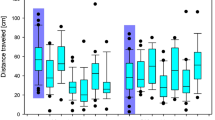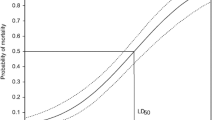Abstract
Imidacloprid is a nicotine-based, systemic, widely used insecticide. In order to investigate the effects of imidacloprid on the spider Pardosa pseudoannulata (Araneae: Lycosidae), specimens were exposed to different concentrations of imidacloprid (12.5, 25, 50, 100, 200 mg/L) by the dipping method. Surviving spiders were used to determine the fecundity, development time of unexposed offspring, predation, and the activities of detoxification enzymes. Significant reductions were observed in survival rate and fecundity of spiders exposed to imidacloprid. The development times of unexposed offspring (F1) were prolonged significantly with increased concentrations of imidacloprid. Spiders exposed to concentrations of imidacloprid above 25 mg/L showed significantly weaker predation on Drosophila melanogaster than the control group, but a low dose of imidacloprid (12.5 mg/L) increased predation ability. The activities of carboxyl esterase, acetyl cholinesterase, and the mixed-function oxidase were significantly inhibited by imidacloprid. With increasing concentrations of imidacloprid, the activities of all three kinds of enzymes were decreased significantly. These results suggest that imidacloprid can stimulate the performance of spiders (in low concentration) and has chronic toxicity to the spiders.

Similar content being viewed by others
References
Babczynska A, Wilczek G, Migula P (2006) Effects of dimethoate on spiders from metal pollution gradient. Sci Total Environ 370:352–359
Bradford MM (1976) A rapid and sensitive method for the quantitation of microgram quantities of protein utilizing the principle of protein-dye binding. Anal Biochem 72:248–254
Bridges CM (2000) Long-term effects of pesticide exposure at various life stages of the southern leopard frog (Rana sphenocephala). Arch Environ Contam Tox 39:91–96
Brunelli E, Bernabò I, Berg C, Lundstedt-Enkel K, Bonacci A, Tripepi S (2009) Environmentally relevant concentrations of endosulfan impair development, metamorphosis and behaviour in Bufo bufo tadpoles. Aquat Toxicol 91:135–142
Calabrese EJ (2008) Hormesis: why it is important to toxicology and toxicologists. Environ Toxicol Chem 27:1451–1474
Calabrese EJ (2010) Hormesis is central to toxicology, pharmacology and risk assessment. Hum Exp Toxicol l29:249–261
Chang LL, Hodgson E (1975) Biochemistry of detoxication in insects: microsomal mixed-function oxidase activity in the housefly, Musca domestica. Insect Biochem 5:93–103
Chapman PM (2001) The implications of hormesis to ecotoxicology and ecological risk assessment. Hum Exp Toxicol 20:499–505
Chen XQ, Zhang ZT, Liu R, Zhang XL, Chen J, Peng Y (2011) Effects of the metals lead and zinc on the growth, development, and reproduction of Pardosa astrigera (Araneae: Lycosidae). Bull Environ Contam Toxicol 86:203–207
Deng LL, Dai JY, Cao H, Xu MQ (2007) Effects of methamidophos on the predating behavior of Hylyphantes graminicola (Sundevall) (Araneae: Linyphiidae). Environ Toxicol Chem 26:478–482
Desneux N, Decourtye A, Delpuech JM (2007) The sublethal effects of pesticides on beneficial arthropods. Annu Rev Entomol 52:81–106
Dinter A, Poehling HM (1995) Side-effects of insecticides on two erigonid spider species. Entomol Exp Appl 74:151–163
Ellman GL, Courtney KD, Anders V, Featherstone RM (1961) A new and rapid colorimetric determination of acetylcholinesterase activity. Biochem Pharmacol 7:88–95
Everts JW, Willemsen I, Stulp M, Simons L, Aukema B, Kammenga J (1991) The toxic effects of deltamethrin on linyphiid and erigonid spiders in connection with ambient temperature, humidity, and predation. Arch Environ Contam Toxicol 20:20–24
Holling CS (1959) The components of predation as revealed by a study of small mammal predation of European pine sawfly. Can Entomol 91:293–320
Hyne RV, Maher WA (2003) Invertebrate biomarkers: links to toxicosis that predict population decline. Ecotoxicol Environ Saf 54:366–374
James DG, Price TS (2002) Fecundity in twospotted spider mite (Acari: Tetranychidae) is increased by direct and systemic exposure to imidacloprid. J Econ Entomol 95:729–732
Jones DK, Hammond JI, Relyea RA (2009) Very highly toxic effects of endosulfan across nine species of tadpole: lag effects and family level selectivity. Environ Toxicol Chem 28:1939–1945
Lengwiler U, Benz G (1994) Effects of selected pesticides on web building behavior of Larinioides sclopetarius (Cleck) (Araneae: Araneidae). J Appl Entomol 117:99–108
Luckey TD (1968) Insecticide hormoligosis. J Econ Entomol 61:7–12
Mandour NS, El-Basha NAS, Liu TX (2006) Functional response of the ladybird, Cydonia vicina nilotica to cowpea aphid, Aphis craccivora in the laboratory. J Insect Sci 13:49–54
Mansour F, Heimbach U, Wehling A (1992) Effects of pesticides on ground-dwelling lycosid and micryphatid spiders in laboratory tests. Phytoparasitica 20:195–202
Marc P, Canard A, Ysnel F (1999) Spiders (Araneae) useful for pest limitation and bioindication. Agric Ecosyst Environ 74:229–273
Mizell RF, Sconyers MC (1992) Toxicity of imidacloprid to selected arthropod predators in the laboratory. Fla Entomol 75:277–280
Peng Y, Shao XL, Hose GC, Liu FX, Chen J (2010) Dimethoate, fenvalerate and their mixture affects Hylyphantes graminicola (Araneae: Linyphiidae) adults and their unexposed offspring. Agric Forest Entomol 12:343–351
Prasad VD, Devi CT, Rao KR, Krishnayya PV (1995) Host plant-induced response to insecticides and haemolymph esterase patterns in Spodoptera litura (Fabricius). Entomon 20:245–248
Rastogi R, Srivastava A, Dhawan BN (1997) Effect of Picroliv on impaired hepatic mixed-function oxidase system in carbon tetrachloride-intoxicated rats. Drug Dev Res 41:44–47
Shi SX, Huang YR, Zhang LF, Zhang XL, Zhou L, Zhang T, Dong L (2011) Organochlorine pesticides in muscle of wild seabass and Chinese prawn from the Bohai Sea and Yellow Sea, China. Bull Environ Contam Toxicol 87:366–371
Stebbing AR (1982) Hormesis—the stimulation of growth by low levels of inhibitors. Sci Total Environ 22:213–234
Stewart CD, Braman SK, Pendley AF (2002) Functional response of the azalea plant bug, Rhinocapsus vanduzeei (Heteroptera: Miridae), and green lacewing, Chrysoperla rufilabris (Neuroptera: Chrysopidae), two predators of the azalea lace bug (Heteroptera: Tingidae). Environ Entomol 31:1184–1190
Toft S, Jensen AP (1998) No negative sublethal effects of two insecticides on prey capture and development of a spider. J Pest Sci 52:223–228
Wang Z, Fu XQ, Song DX, Yan HM (2006) Effect of low-dose chemical pesticides on distribution and activity of carboxylesterase and acetylcholinesterase in the wolf spider, Pardosa pseudoannulata (Araneae: Lycosidae). Acta Ecol Sin 49:260–264
Watanabe M (1993) The influence of eight kinds of pesticides upon the spider, Misumenops tricuspidatus. Proc Kanto-Tosan Plant Prot Soc 197–198
Yang EH, Yang Y, Wu S, Wu YD (2005) Relative contribution of detoxifying enzymes to pyrethroid resistance in a resistant strain of Helicoverpa armigera. J Appl Entomol 129:521–525
Yu YS, Shen GQ, Lu YT (2010) Hormetic effect of imicacloprid on fecundity of Myzus persicae (Sulzer) and impacts on the control efficiency of Pirata subpiraticus. Bull Sci Technol 26:779–883
Zeng CX, Wang JJ (2010) Influence of exposure to imidacloprid on survivorship, reproduction and vitellin content of the carmine spider mite, Tetranychus cinnabarinus. J Insect Sci 10:1–9
Acknowledgments
This study was supported by the National Natural Science Foundation of China (31071895), the Foundation of Hubei Provincial Department of Education (Q20111001) and the Key Scientific and Technological Projects of Wuhan (201120722216-3). We thank Dr. Janet W. Reid (Biological consulting and editing services, JWR Associates, New York, USA) for emending the English of the manuscript.
Author information
Authors and Affiliations
Corresponding author
Rights and permissions
About this article
Cite this article
Chen, Xq., Xiao, Y., Wu, Lb. et al. Imidacloprid Affects Pardosa Pseudoannulata Adults and Their Unexposed Offspring. Bull Environ Contam Toxicol 88, 654–658 (2012). https://doi.org/10.1007/s00128-012-0584-0
Received:
Accepted:
Published:
Issue Date:
DOI: https://doi.org/10.1007/s00128-012-0584-0




